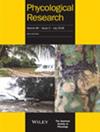Revealing the species diversity of Neolyngbya (Cyanobacteria, Oscillatoriales) from subtropical coastal regions of Okinawa, Japan, with descriptions of Neolyngbya intertidalis sp. nov. and Neolyngbya latusa sp. nov.
IF 1
4区 生物学
Q2 MARINE & FRESHWATER BIOLOGY
引用次数: 2
Abstract
Okinawan coasts are a rich source of biodiversity, including of filamentous cyanobacteria, owing to their habitat diversity created by coral reefs. Along the coastlines of Okinawa, several undescribed species, including those from Neolyngbya, remain unexplored. In this study, two undescribed cyanobacterial species with morphological resemblance to Neolyngbya were identified using a polyphasic approach. Both taxa had morphological features similar to known species of Neolyngbya; however, the cell size and thallus shape were different. Phylogenetic analyses of the 16S rRNA gene and the 16S‐23S rRNA internal transcribed spacer (ITS) region showed that the two new species formed a highly supported independent subclade within Neolyngbya. Accordingly, three informative domains of the ITS region (D1‐D1′, Box B and V3) also presented distinct secondary structures compared to previously described species of Neolyngbya, both in structure form and configuration. Overall, analyses of morphology and phylogeny of the 16S rRNA gene and the 16S‐23S rRNA ITS region, as well as the secondary structures of ITS region, supported the proposal of two new species within Neolyngbya. Herein, we propose N. intertidalis sp. nov. and N. latusa sp. nov. as new members of Neolyngbya under the provisions of the International Code of Nomenclature for Algae, Fungi and Plants (ICN).以日本冲绳亚热带沿海地区neolyynbya intertidalis sp. 11和neolyynbya latusa sp. 11为例,揭示了neolyynbya的物种多样性。
由于珊瑚礁创造的栖息地多样性,冲绳海岸是生物多样性的丰富来源,包括丝状蓝藻。在冲绳岛的海岸线上,有几个未被描述的物种,包括那些来自新大陆的物种,仍未被发现。在这项研究中,两种未描述的蓝藻物种与形态学上的相似,以多相方法鉴定。这两个分类群的形态特征与已知的新林属相似;但细胞大小和菌体形状不同。对16S rRNA基因和16S‐23S rRNA内部转录间隔区(ITS)的系统发育分析表明,这两个新种在新林属中形成了一个高度支持的独立亚枝。因此,ITS区域的三个信息域(D1‐D1′,Box B和V3)在结构形式和配置上也与先前描述的物种相比呈现出不同的二级结构。总体而言,16S rRNA基因和16S‐23S rRNA ITS区域的形态和系统发育分析,以及ITS区域的二级结构,支持了在新林属中存在两个新种的说法。在此,我们根据国际藻类、真菌和植物命名规则(ICN)的规定,推荐N. intertidalis sp. 11和N. latusa sp. 11作为neolyynbya的新成员。
本文章由计算机程序翻译,如有差异,请以英文原文为准。
求助全文
约1分钟内获得全文
求助全文
来源期刊

Phycological Research
生物-海洋与淡水生物学
CiteScore
3.60
自引率
13.30%
发文量
33
审稿时长
>12 weeks
期刊介绍:
Phycological Research is published by the Japanese Society of Phycology and complements the Japanese Journal of Phycology. The Journal publishes international, basic or applied, peer-reviewed research dealing with all aspects of phycology including ecology, taxonomy and phylogeny, evolution, genetics, molecular biology, biochemistry, cell biology, morphology, physiology, new techniques to facilitate the international exchange of results. All articles are peer-reviewed by at least two researchers expert in the filed of the submitted paper. Phycological Research has been credited by the International Association for Plant Taxonomy for the purpose of registration of new non-vascular plant names (including fossils).
 求助内容:
求助内容: 应助结果提醒方式:
应助结果提醒方式:


